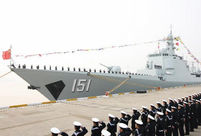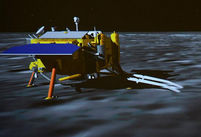 Famous Lanzhou beef noodles
Famous Lanzhou beef noodles Armed Police hold anti-terrorism drill in SE China's Xiamen
Armed Police hold anti-terrorism drill in SE China's Xiamen Harbin Int'l Ice and Snow Festival opens
Harbin Int'l Ice and Snow Festival opens 'Jin' named the word of the year by cross-strait netizens
'Jin' named the word of the year by cross-strait netizens Chinese scientific expedition goes to build new Antarctica station
Chinese scientific expedition goes to build new Antarctica station
 Chinese naval escort fleet conducts replenishment in Indian Ocean
Chinese naval escort fleet conducts replenishment in Indian Ocean 17th joint patrol of Mekong River to start
17th joint patrol of Mekong River to start China's moon rover, lander photograph each other
China's moon rover, lander photograph each otherExperimental observation of the quantum anomalous hall effect in a magnetic topological insulator
The research team led by Professor Qikun Xue from Tsinghua University, in collaboration with researchers from the Institute of Physics of the Chinese Academy of Sciences and Stanford University, made a breakthrough in the field of condensed matter physics. They reported the first experimental observation of the quantum anomalous Hall Effect, which represents a very important new phenomenon discovered first by Chinese physicists, as reported in the online edition of Science. The team has worked on the project for four years, testing more than 1000 samples.
Manned Sub Jiaolong completes deep-sea dive
On June 10 China's manned submersible Jiaolong, boarding its support ship Xiangyanghong-9, left port in Jiangyin of east China's Jiangsu province for its first voyage of experimental application in 2013. During the 103-day mission, the sub made several research dives in the South China Sea, the northeast Pacific Ocean, and the west Pacific. Jiaolong set a new depth record after descending to 7,062 meters in the Pacific Ocean's Mariana Trench in June 2012. This means that the submersible is capable of conducting deep-sea research and resource exploration in 99.8 percent of the world's oceans.
Shenzhou-10, China's first application-oriented space flight
The Shenzhou-10 manned spacecraft was launched at the Jiuquan Satellite Launch Center on June 11, 2013. During its 15-day journey in space, Shenzhou-10 docked twice with the orbiting space lab Tiangong-1, once through automatic operation and the other under manual control.
The three astronauts, two men and a woman, spent 12 days in Tiangong-1, where they conducted medical experiments and technical trials, and delivered a lecture to students on Earth about basic principles of physics.
Compared with the previous Shenzhou-9 mission last year, Shenzhou-10 is no longer experimental but considered an applicable shuttle system for transporting astronauts and supplies to orbiting modules. It was China's longest space flight yet conducted. The mission aimed to further test technologies designed for docking and supporting astronauts in space, as well as to use new technologies related to the future construction of a space station.
Stem cells reprogrammed using only chemical processes
After 5 years of work, the team led by Deng Hongkui, a stem-cell biologist at Peking University in Beijing, screened 10,000 small molecules to find chemical substitutes for genes. Deng's team searches for small-molecule compounds that could reprogram cells in the presence of all the usual genes. The revolutionary life science research has attracted the attention of the international academic community. The results of this study were published in the prestigious journal Science on July 18.
China builds Taishan station in Antarctica
China built a new research station in Antarctica called Taishan. It was China’s fourth research station in the southern pole, serving as the country's fourth summer field camp and Antarctic base in Princess Elizabeth Land.
China's lunar probe Chang'e-3, with the country's first moon rover
China's lunar probe Chang'e-3, carrying the country's first moon rover successfully landed on the moon on Dec 14 2013, marking the first time that China has sent a spacecraft to soft land on the surface of an extraterrestrial body. Following the successes of the Chang'e-2 missions, which included plotting a high-resolution, full-coverage lunar map, the Chang'e-3 mission was the second phase of China's lunar program, and included orbiting, landing and returning to Earth.
China releases 4G licenses
China awarded licenses for speedier mobile services on Dec 4, 2013, paving the way for the country's state-owned telecommunications carriers to accelerate building new networks. The licenses will allow China's telecom operators to run fourth-generation mobile technology. The new networks are expected to prove a boon to China's numerous Internet companies, which are seeking speedier mobile connections to provide services to China's growing number of smart phone users.
China elects 104 new academicians
On 19th December 2013, the Chinese Academy of Sciences (CAS) and the Chinese Academy of Engineering (CAE) announced the names of their newly elected Academicians, the highest academic honor in the field of science and technology in China. 53 of 391 nominated candidates were elected as CAS Academicians on this occasion, expanding the CAS membership to 750. CAE elected 51 of 560 candidates, which brought its total number of Academicians to 807.
In addition, CAS elected 9 new foreign Academicians from the USA, France, Denmark, Israel, Brazil and India, including Israeli Nobel Prize winner Aaron Ciechanover. CAE also elected 6 foreign members from the USA, Australia and Denmark.
 Chinese Consulate General in S.F. burned for arson attack
Chinese Consulate General in S.F. burned for arson attack Roar of J-15 fighter is melody for operator on the Liaoning
Roar of J-15 fighter is melody for operator on the Liaoning A 90-year-old forester's four decades
A 90-year-old forester's four decades Most touching moments in 2013
Most touching moments in 2013 2013: Joys and sorrows of world politicians
2013: Joys and sorrows of world politicians Missile destroyer Zhengzhou commissioned to Chinese navy
Missile destroyer Zhengzhou commissioned to Chinese navy China is technically ready to explore Mars
China is technically ready to explore Mars Photo story: Life changed by mobile technology
Photo story: Life changed by mobile technology Bullet train attendants' Christmas Eve
Bullet train attendants' Christmas Eve Heart-warming Laba porridge
Heart-warming Laba porridge Gallery: China's trapped icebreaker makes successful escape
Gallery: China's trapped icebreaker makes successful escape Photo story: We are special soldiers
Photo story: We are special soldiers 'Rong' selected HK's character of the year for 2014
'Rong' selected HK's character of the year for 2014 Famous Lanzhou beef noodles
Famous Lanzhou beef noodles Chinese Consulate Arson Suspect Makes 1st Court Appearance
Chinese Consulate Arson Suspect Makes 1st Court AppearanceDay|Week|Month